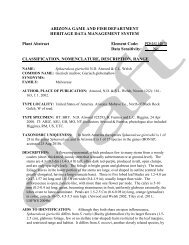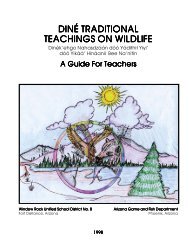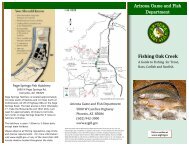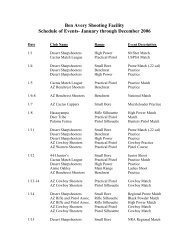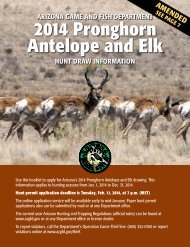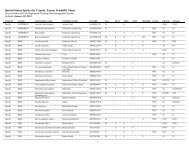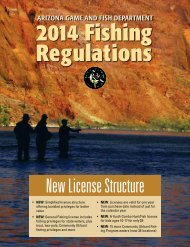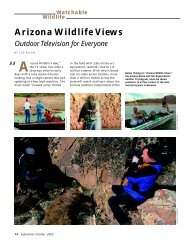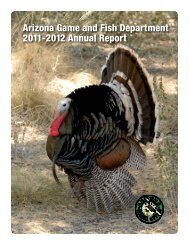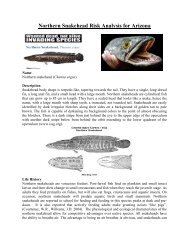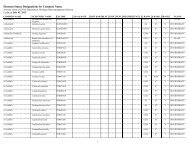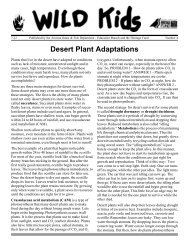2013-14 Arizona Hunting Regulations - Arizona Game and Fish ...
2013-14 Arizona Hunting Regulations - Arizona Game and Fish ...
2013-14 Arizona Hunting Regulations - Arizona Game and Fish ...
- No tags were found...
Create successful ePaper yourself
Turn your PDF publications into a flip-book with our unique Google optimized e-Paper software.
<strong>Arizona</strong> <strong>Game</strong> <strong>and</strong> <strong>Fish</strong> Commission Rules About <strong>Hunting</strong>matter shall be submitted to the Commission for determination.G. An individual may use a vehicle on or off a road to pickup lawfully taken big game animals.H. The closing of state l<strong>and</strong> to hunting, fishing, or trappingshall not restrict any other permitted use of the l<strong>and</strong>.I. State trust l<strong>and</strong> may be posted with signs that read“State L<strong>and</strong> No Trespassing” but such posting shall notprohibit access to such l<strong>and</strong> by any individual lawfullytaking or retrieving wildlife.J. The Commission may grant permission to lock or obliteratea gate or close a road or trail that provides legallyavailable access to state l<strong>and</strong>s for licensed hunters <strong>and</strong>fishermen if access to such l<strong>and</strong>s is provided by a reasonablealternate route. Under R12-4-610, the Directormay grant a permit to a state l<strong>and</strong> lessee to temporarilylock a gate or close an existing road that providesaccess to state l<strong>and</strong>s if the taking of wildlife will causeunreasonable interference during a critical livestock orcommercial operation. This permit shall not exceed 30days. Applications for permits for more than 30 daysshall be submitted to the Commission for approval. If apermit is issued to temporarily close a road or gate, acopy of the permit shall be posted at the point of the closureduring the period of the closure.K. When hunting, fishing, or trapping on state l<strong>and</strong>, alicense holder shall not:1. Break or remove any lock or cut any fence to gainaccess to state l<strong>and</strong>;2. Open <strong>and</strong> not immediately close a gate;3. Intentionally or wantonly destroy, deface, injure,remove, or disturb any building, sign, equipment,marker, or other property;4. Harvest or remove any vegetative or mineralresources or object of archaeological, historic, or scientificinterest;5. Appropriate, mutilate, deface, or destroy any naturalfeature, object of natural beauty, antiquity, or otherpublic or private property;6. Dig, remove, or destroy any tree or shrub;7. Gather or collect renewable or non-renewableresources for the purpose of sale or barter unlessspecifically permitted or authorized by law; or8. Frighten or chase domestic livestock or wildlife, orendanger the lives or safety of others when using amotorized vehicle or other means.R12-4-111Identification NumberA. An applicant for a Department identification numbermay either:1. Assign his or her own number by using his or hersocial security number; or2. Obtain a number from the Department by providingthe Department with full name <strong>and</strong> any aliases, dateof birth, <strong>and</strong> mailing address.R12-4-112Diseased, Injured, or Chemically ImmobilizedWildlifeA. The Director may authorize Department employees tocondemn the carcass of a lawfully taken <strong>and</strong> lawfullypossessed diseased, injured, or chemically immobilizedwildlife taken under any permit tag that is, in the opinionof the employee, unfit for human consumption, ifthe individual who took the wildlife requests it <strong>and</strong> thiscondition was not created by the actions of the individualwho took the wildlife. A Department employeemay condemn wildlife that is chemically immobilized ifthe wildlife was taken during the established withdrawalperiod of that immobilizing drug.B. The individual who took the wildlife shall surrender theentire condemned wildlife carcass <strong>and</strong> any parts thereofto the Department employee.C. After condemnation <strong>and</strong> surrender of the wildlife, theDepartment employee shall provide written authorizationto the individual who took the wildlife to purchase<strong>and</strong> use a duplicate tag. The license holder may purchasethe tag from any dealer where the tag is available.The license dealer shall forward the written authorizationto the Department with the report of the tag sale.R12-4-1<strong>14</strong>Issuance of Nonpermit-tags <strong>and</strong> HuntPermit-tagsA. In accordance with A.R.S. § 17-332 <strong>and</strong> the provisions ofthis Section, the Department shall annually provide numberedtags for sale to the public. The Department shallensure that each tag includes a transportation <strong>and</strong> shippingpermit as prescribed in A.R.S. §§ 17-332 <strong>and</strong> 17-371,<strong>and</strong> that each tag is made of tear-resistant material withan adhesive back covered by a detachable paper backing<strong>and</strong> clearly identifies the animal for which the tag isvalid.B. If the Commission establishes a big game season forwhich a hunt number is not assigned, the Department orits authorized agent, or both, shall sell nonpermit-tags.1. To obtain a nonpermit-tag, an applicant shall provideto a license dealer or Department office theapplicant’s name, home mailing address, <strong>and</strong>Department identification number.2. An applicant shall not apply for or obtain nonpermit-tagsin excess of the bag limit prescribed bythe Commission when it established the season forwhich the nonpermit-tags are valid.C. If the number of hunt permits for a species in a particularhunt area must be limited, a Commission Orderestablishes a hunt number for that hunt area, <strong>and</strong> a huntpermit-tag is required to take the species in that huntarea.1. To apply for a hunt permit-tag, an applicant shallsubmit an application under R12-4-104.2. The Department shall use the following procedureto determine whether a hunt permit-tag will beissued to an applicant:a. The Department shall reserve a maximum of20% of the hunt permit-tags for each huntnumber for antelope, bear, deer, elk, javelina,<strong>and</strong> turkey to issue to individuals <strong>and</strong> groupsthat have bonus points. The Department shallreserve a maximum of 20% of the hunt permittagsfor all hunt numbers combined statewidefor bighorn sheep <strong>and</strong> buffalo to issue to individuals<strong>and</strong> groups that have bonus points.b. The Department shall issue the reserved huntpermit-tags for hunt numbers designated by eligibleapplicants as their first or second choices.The Department shall issue the reserved huntpermit-tags by r<strong>and</strong>om selection:i. First, to eligible applicants with the highestnumber of bonus points for that genus;ii. Next, if there are reserved hunt permittagsremaining, to eligible applicants withthe next highest number of bonus pointsfor that genus; <strong>and</strong>iii. If there are still tags remaining, to the nexteligible applicants with the next highestnumber of bonus points; continuing inthe same manner until all of the reservedtags have been issued or until there are nomore applicants for that hunt number whohave bonus points.c. The Department shall ensure that the first selectionfrom all unreserved hunt permit-tags is byr<strong>and</strong>om drawing.d. If the bag limit established by CommissionOrder is more than one per calendar year, or ifthere are hunt permit-tags remaining unissuedafter the r<strong>and</strong>om drawings, the Departmentshall ensure that these hunt permit-tags areavailable on a set date on a first-come, firstservedbasis as specified in the hunt permit-tagapplication schedule published annually.D. The Department shall not make available more than onehunt permit-tag or 10% of the total hunt permit-tags,whichever is greater, for bighorn sheep or buffalo in anydraw to nonresidents. The Department shall not makeavailable more than 50% nor more than two bighornsheep or buffalo hunt permit-tags of the total in any huntnumber to nonresidents.E. The Department shall not make available more than10%, rounded down, of the total hunt permit-tags inany hunt number to nonresidents for antelope, antlereddeer, bull elk, javelina, or turkey. If a hunt number forantelope, antlered deer, bull elk, javelina or turkey hasten hunt permit-tags or fewer, no more than one huntpermit-tag will be made available to a nonresident,except that if a hunt number has only one hunt permittag,that tag shall only be available to a resident.F. Any cap established under this Section applies only tohunt permit-tags issued by r<strong>and</strong>om drawing under subsections(C)(2)(b) <strong>and</strong> (c).R12-4-115Supplemental Hunts <strong>and</strong> Hunter PoolA. For the purposes of this Section, the following definitionsapply:1. “Management objectives” means goals, recommendations,or guidelines contained inCommission-approved wildlife management plans,which include hunt guidelines, operational plans, orhunt recommendations;2. “Hunter pool” means all individuals who have submittedan application for a supplemental hunt; <strong>and</strong>3. “Supplemental hunt” means a season established bythe Commission for the following purposes:a. Take of depredating wildlife under A.R.S. §17-239;b. Take of wildlife under an Emergency Season ifthe Commission adopts, amends, or repeals aCommission Order for reasons constituting animmediate threat to the health, safety, or managementof wildlife or its habitat or to publichealth or safety; orc. Take of wildlife under a population managementhunt if the Commission has prescribedrestricted nonpermit-tags by Commission Orderfor the purpose of meeting management objectivesbecause regular seasons are not, have notbeen, or will not be sufficient or effective toachieve management objectives.B. For the purposes of authorizing a population managementhunt, the Commission through CommissionOrder shall open a season or seasons <strong>and</strong> prescribe amaximum number of restricted nonpermit-tags that theDirector may issue under this Section.C. The Director shall implement a population managementhunt under the open season or seasons prescribed insubsection (B) if the Director finds that:1. Regular seasons have not met or will not meet managementobjectives;2. Take of wildlife is necessary to meet managementobjectives; <strong>and</strong>3. Issuance of a specific number of restricted nonpermit-tagsis likely to meet management objectives.D. To implement a population management hunt undersubsection (B), the Director shall do the following:1. Select season dates, within the range of dates prescribedby the Commission through CommissionOrder;2. Select specific hunt areas, within the range of huntareas prescribed by the Commission through CommissionOrder;120 <strong>Arizona</strong> <strong>Game</strong> <strong>and</strong> <strong>Fish</strong> Department — www.azgfd.gov



